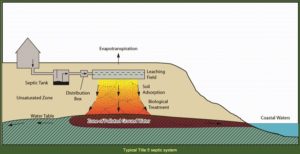EASTHAM — Stephen and Mimi Henning own a small house off Steele Road on about a third of an acre. Built in 1935, it has two bedrooms and a bathroom, a living room, kitchen, and a little screened porch. They want to add a three-season room.
That addition brought them to the board of health on May 28, where they learned that their septic system needs to do a better job with wastewater.
Noting that Eastham has “neighborhoods with lots of small properties,” chair Joanna Buffington explained the septic system problem: “Even with all the improvements in Title 5, we continue to see deterioration of our groundwater and estuaries, so we have been looking to do the best we can on these small properties.” Her sense, she said, was that the Hennings’ plan looked reasonable. “But there’s an opportunity to upgrade the septic system for better nitrogen control, especially with that close groundwater distance.”
“You’re saying we need a new septic system to do this project?” asked Mimi Henning.
Not quite, Buffington indicated. What’s needed, she said, is an upgrade to add a nitrogen-reduction component.
“I don’t really understand,” Henning said. “We have almost a third of an acre. It’s not really a small lot.”
“By today’s standards, this couldn’t be built on at all,” Buffington said, adding that lots like the Hennings’ are grandfathered in and, by current standards, overbuilt.

Jane Crowley, the town’s director of health and environment, noted that the bottom of the leach field on the plan showed 48 inches to observed groundwater. “That’s not much distance,” she said. “There’s not a lot of opportunity for the soil as a treatment mechanism to denitrify and decontaminate the effluent before it hits groundwater.”
The bottom line, she said, “is that the standard for construction is very different than it was under the [previous] code. This board now reviews the adequacy of the system.”
Mimi Henning, who said the property is being hooked up to town water, said she was “having a little problem with spending $15,000 to replace the septic system. That’s half of what we’re doing for this addition.”
“We’re not talking about replacing your whole system,” health board member Francie Williamson said. “We’re telling you that there are now things you can add to your system to make it more functional.”
“Adding footage to a home in an environmentally sensitive area surrounded by houses using wells” triggers the board’s review, said Buffington. “That’s our task, trying to protect groundwater.”
Stephen Henning asked for greater clarity regarding what the board wanted. Crowley suggested hiring an engineer to do borings to evaluate the location of maximum high groundwater, which would then reveal “opportunities to add components, which may or may not be feasible in your case.” The options might include secondary treatment or the addition of innovative/alternative technology, a new leach area, or a completely new system combining those elements.
“It really is your job to craft a proposal for the board’s consideration,” she said. From the board’s point of view, the existing system is “not the most desirable for the request today.”
“We’ll do some homework and get some better information and a proposal and come back,” Stephen Henning said. The board took no action, other than agreeing to continue the hearing at a later date.



